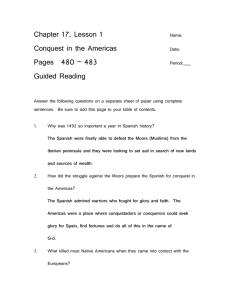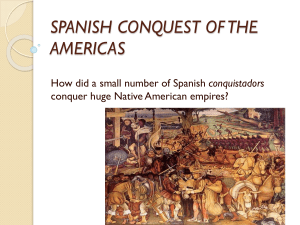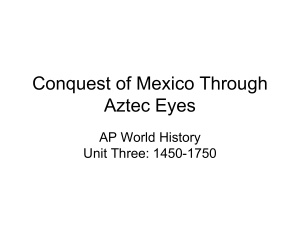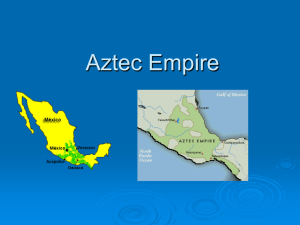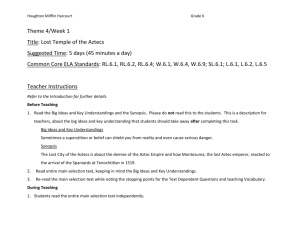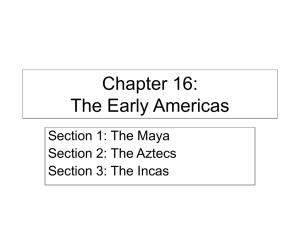Cortes and Quetzalcoatl
advertisement
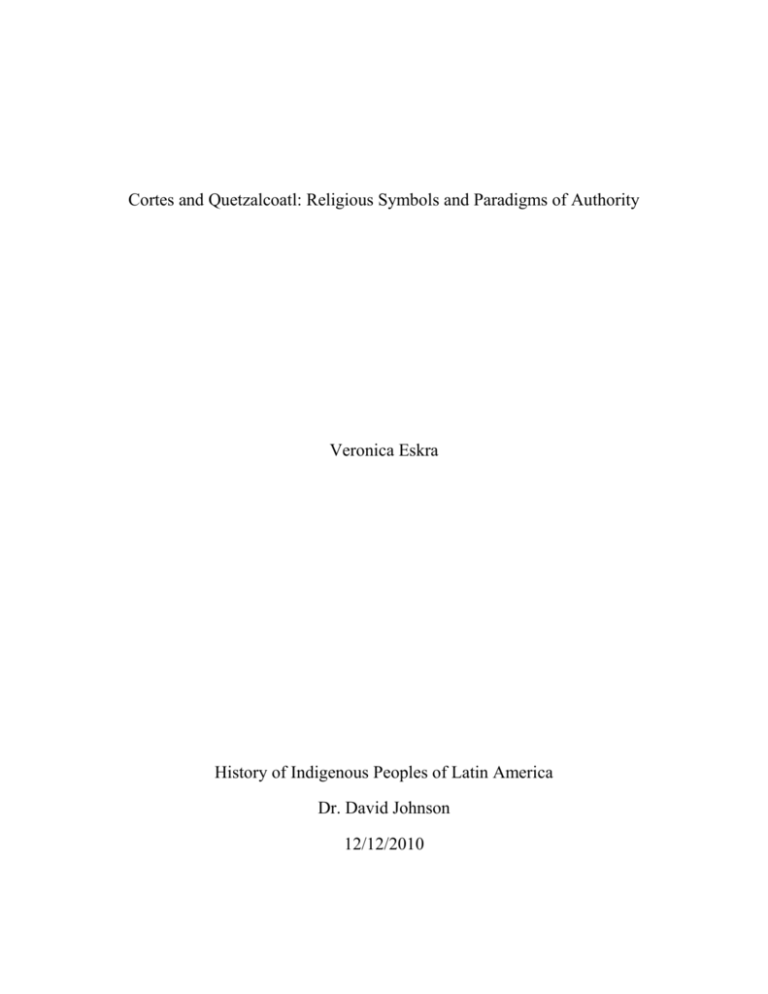
Cortes and Quetzalcoatl: Religious Symbols and Paradigms of Authority Veronica Eskra History of Indigenous Peoples of Latin America Dr. David Johnson 12/12/2010 In the past thirty years, historians have reconsidered their traditional ideas of Aztec religion as it influenced pre-Hispanic and post Conquest historical events. Archaeological discoveries in the past few decades, including the Pyramid of Quetzalcoatl in Teotihuacan, have given rise to new discourses and interpretations of the role religion played in Mexican life before the arrival of the Spanish, and religious influence the outcome of the first contact. The first historiographers of Mexico were Franciscan friars, most notably Bernardo de Sahagun, who wrote with a Spanish bias and the help of conquered Nahuas. From Sahagun and other chroniclers, historians wrote heroically about the achievements of conquistadors like Cortes and missionaries who converted indigenous masses. In the 19th century, William Prescott wrote History of the Conquest of Mexico, a tribute to “European and North American versions of imperial and expansionist ideology.”1 The lingering effects of Prescott, Sahagun, and Cortes’s own heroic historiography are seen in the publication of modern histories, including Hugh Thomas’ Conquest in 1995, and Tzvetan Todorov’s The Conquest of America in 1939. As historian Evan Young observed, “There has been a tendency for Anglophone writers on Mexican history to treat Mexico as a problem - a problem in economic backwardness, a problem in political instability… What can only be seen as a patronizing attitude has been wide-spread among U.S. intellectuals but also deeply embedded in the collective perceptions of Americans as a whole.”2 The publication of Miguel Leon-Portilla’s Broken Spears in 1959 was the first revisionist history on the topic, and focused primarily on Nahua interpretations of events. Prescottian historiography concerning the first contact between Spanish and Indigenous portrays the Aztec as a people doomed by their religious devotion, omens, and superstitions. The Eurocentric legend proposes that when Cortes and his men first appeared on the outskirts of 1 2 Restall, 17. Ibid. Tenochtitlan, he was mistaken for the god Quetzalcoatl, essentially giving him a free pass to the vast wealth of the Aztec empire. In this story, the Spaniards are portrayed as savvy, competent, and all-powerful over the fearful Aztecs. The Aztecs, on the other hand, were “defeated by terror,”3 as pro-Indigenous historian Eduard Galleano says in Open Veins of Latin America (published 1973). Most revisionist and cultural historians do not accept this telling of events as truth, and instead provide a more complex and realistic interpretation. Historians are reexamining “The religious and political significance of the Quetzalcoatl myth - particularly the myth of his return and its disputed role in the conquest of Tenochititlan.”4 This paper will approach the topic of religion in Mexico from a more nuanced perspective, without romanticizing Spanish sources and with the understanding that a cosmic worldview radically different from European Christianity influenced indigenous people. Yet that cosmic orientation was able to evolve and influence the resulting Mexican Catholicism after the conquest. This paper intends to place indigenous views of the god Quetzalcoatl in context and explain the significance of Quetzalcoatl as a figure of political and religious authority pre-Contact in relation to Conquest and the ensuing religious transformation. With this revisionist interpretation of history, there arises the question of agency. It would be unrealistic to think that the Aztec peoples had no power at all to affect any outcome of the Conquest. While the Spaniards had technology and disease on their side, the indigenous did not hand over their empire without resistance. Religion played a major and sometimes indirect role in the behavior of the Aztecs, most often through religiously founded political propaganda. If, as Galleano said, the Aztecs were definitively conquered by terror of the ‘man-gods’ entering their land, then perhaps they did not possess any agency. Their blind faith may have lead them to the 3 4 Galeano, 17 Carrasco, ix inevitable outcome of defeat. But as historian Matthew Restall states, “The Spaniards as Gods myth makes sense only if natives are assumed to be primitive, child-like, or half-witted.”5 And in light of the advanced civilization that is still being unearthed and explained, one could conclude that the Aztecs were definitely not primitive, child-like, or half-witted. Yet if the Aztecs were not so easily fooled by Spanish appearances and politics, what agency did they possess? Aztec religious beliefs certainly influenced the empire’s reactions to the Spanish, and the technology and diseases of Europeans overwhelmed the indigenous resistance. But “Recent emphasis on subaltern agency does not mean that colonialists are constructing a new White Legend of colonial society … rather that they are painting a more nuanced picture of what formerly looked pretty uniformly grim and monochromatic.”6 Another theory suggests the indigenous purposefully gave up agency in order to preserve the honor of their kingdom. “Omens [and prophecies] were likely composed by post- Conquest native raconteurs who sought to demonstrate … the inevitability of this event. Viewed in this fashion, the Mexica were powerless to alter their fate, and their glory, then, would remain untarnished by the Conquest.”7 By examining the different types of historiography employed, one can better pinpoint the avenues of indigenous agency. As this paper intends to focus specifically on revising the Spaniards-as-Gods myth and Quetzalcoatl’s significance, the question of agency will be answered through religious context. 5 Restall, 120 Young, 281-282 7 Colston, 240. 6 Quetzalcoatl, Topiltzin, and the Aztecs: Mesoamerican Religious Symbols Historian Benjamin Keene calls the Aztecs “The Assyrians of the Americas,”8 the last indigenous tribe to arrive and conquer in the Mexican region before the Spanish. The coastal Olmec civilization, which Keene calls “the mother civilization” of Mesoamerica, was established around 600 B.C., nearly 2,000 years before the Aztecs came to power. Residents of the central highland region built the pyramids at Teotihuacan before A.D. 250 and were the first to worship the dual gods Tlaloc and Quetzalcoatl. The importance of these gods in Teotihuacan culture can be seen by their prominence in sculpture, murals, and the great temples located in the center of the city. Teotihuacan remained one of the most powerful civilizations of the Classic era until the end of the 7th Century, when the city was razed by invading tribes from the North.9 These militaristic tribes marched against the civilizations of the Classic era, giving way to a new hegemony. “Priests and kindly nature gods had presided over the hieratic societies of the Classic era; warriors and terrible war gods dominated the states that established themselves on the ruins of the Classic world.”10 The Teotihuacan Empire disintegrated into a multitude of militaristic states ruled by the intruding ‘savages.’ Out of this chaos rose the Toltec Empire, ruled by the chief Mixcoatl and later his son, Topiltzin-Quetzalcoatl. The Toltecs reached their peak under Topiltzin’s leadership. Topiltzin made Tula the Toltec capitol in 980, managing to earn the love of the conquered Teotihuacan. As ruler, Topiltzin created a legendary city, a “true paradise on earth where cotton grew in colors, where the soil yielded fruit of such giant size that inferior grain was used only to heat steam baths,”11 as 8 Keene, 4. Keene, 6. 10 Ibid, 7. 11 Ibid, 8. 9 described in The Song of Quetzalcoatl. The Toltecs/Teotihuacans were skilled craftsmen and scientists whom legend made superhuman. The conquered Teotihuacanos bestowed Topiltzin with the name ‘Quetzalcoatl’ to identify his position as high priest and king of their society. But the Toltecs had brought their own gods to Mexico, and despite Topiltzin’s affinity for the Teotihuacan there were other factors at work. The struggle between Toltec and Teotihuacan is best exemplified in the Nahuatl legend where the Toltec god Tezcatlipoca used black magic to exile the priest-king Quetzalcoatl. Quetzalcoatl then travelled to the east, sailed across the ocean on a raft of snakes and vowed to one day return and reclaim his throne.12 In this story, the real Quetzalcoatl was overpowered by militant Toltec political groups. This legend, and Quetzalcoatl’s loss of his kingdom and prophesied return, is significant in understanding the role of Quetzalcoatl in the later Aztec civilization. “The legend of Quetzalcoatl made a profound impression on the folk culture of ancient Mexico and played its part in the destruction of the Aztec Empire.”13 As the Toltecs crumbled to the Chichimec’s and Aztecs slowly rose to power, the myth of Quetzalcoatl remained. The Aztec arrived in Mexico in 1218, the last of the Chichimec tribes to enter the region. In 1345, they began building the famed city of Tenochtitlan. For the majority of this period, the Aztec were subject to their dominant neighbors, the Atzcapotzalco. In 1427, the Aztecs joined Texcoco and Tlacopan against the Atzcapotzalco. This rebellion opened a power-vacuum which the Aztecs were quick to fill. By the late 15th century, the Aztecs were dominant across much of central and southern Mexico. An aggressive, militant culture separated the Aztec warrior elites from the varied sub communities throughout the conquered region. Thus, the Aztecs were only in power for a short time before the arrival of the Spanish, and were still trying to establish the 12 13 Boone, 88. Keene, 8. legitimacy of their governance. Despite Aztec reconstruction of local myths and legends to suit their political agenda, Quetzalcoatl remained a significant symbol of the surviving Teotihuacandescended peasants. When the Aztecs came into power, they inherited a mass of people and their beliefs. As Europeans would do only a few decades later, the Aztecs combined the existing religion of the Teotihuacan and Toltecs with their own beliefs, using the new mythology in an attempt to secure their place in power. Building upon the existing cosmology, the Aztecs claimed that their nobility had been given the privilege to rule in place of legendary Quetzalcoatl. According to Toltec legend, all ages were destined to end on a predetermined date with the destruction of humanity; Quetzalcoatl was the god responsible for reviving and protecting man-kind. To further mystify and stabilize their authority, the Aztecs claimed to be able to avoid the end of the age through human sacrifice to their god, Huitzipochtli. The Aztecs created a distinct social chasm between themselves and their conquered subjects through religious duality. While the Aztecs were “sun warriors,” the tribute paying tribes-people were peasants of earth and water.14 The remaining Tollans and Teotihuacans, still under the cosmic influence of Quetzalcoatl, feared the militant Aztecs. When an Aztec army conquered a village, the warriors would march hundreds of captives back to Tenochtitlan for sacrifice. A steward would often stay in the town to ensure that tribute was paid, and land was partitioned off either as a fief for distinguished warriors or to be cultivated by locals to support upper-class Aztecs. Peasants were also responsible for supplying all sacrificial needs. Once a family had lost all of their possessions to the burden of religious tribute, they were forced to sell or pledge their 14 Keene, 33 land. Yet the premise of Aztec authority was invented by religious leaders and nobility who claimed a sacred genealogy, that they were stewards of Quetzalcoatl.15 While the Aztecs used sacrifice and other religious symbols in attempt to legitimize their governance, Quetzalcoatl’s return loomed on the horizon. “The return of Quetzalcoatl uncovered an atmosphere of cosmic instability and cultural inferiority that had apparently plagued the Aztec capital since its foundation… they suffered the anxiety that their authority was illegitimate and that their city would be subject to a lethal blow from the gods.”16 The Aztec likely knew that their religious rhetoric was flawed, but they ultimately had the stronger military force. David Carrasco describes this situation as a result of “guilty rhetoric” from the Aztecs.17 Using the symbolic imagery of the human heart to reinforce the claim to religious and political authority also played on the significant use of human sacrifice to reinforce Aztec domination. As Carrasco explains, the Aztec preached against the very sins they committed, for the gods they claimed to worship but did not, and for the legal system they often ignored.18 The Aztec empire was founded on unstable rhetoric; while they claimed to be avoiding an apocalypse through human sacrifice, the very method of empirical control, the worldview they preached to justify their authority rested upon predestined cycles of decomposition, death, and rebirth.19 The conquered villages’ and cities’ inability to unite against the impenetrable Tenochtitlan bred resentment amongst the vassals who held tightly to their own traditions and beliefs. Before the Spanish even arrived in Tenochtitlan, the Aztecs faced serious internal crises. Toltec legend tells that Quetzalcoatl spent his first days of exile creating arrows. The victims of these arrows would depend on which day the god chose to return to his kingdom. If he returned on 1 15 Carrasco, “Irony of Empire,” iii. Ibid, 150 17 Carrasco, “Guilty Rhetoric,” 4 18 Ibid, 4. 19 Ibid, 25. 16 Crocodile, he would strike at old men and women. If on 1 Jaguar, 1 Deer, or 1 Flower, he would strike at children. But if he returned on 1 Reed, he would strike at kings. 20 The Moment of…Truth? Immediate Responses to the Spanish When the Spanish arrived outside Tenochtitlan in 1520, the year called 1 Reed, the Aztecs were already dealing with an internal crisis. Given the cosmic implications of a hostile foreigner showing up whilst the Aztecs played Quetzalcoatl, one might assume that the Aztecs had no choice but to give up their empire to the Europeans to avoid severely damaging their political legitimacy. Quite the paradox, considering Quetzalcoatl was more of a political symbol used in Aztec rhetoric than a significant religious symbol for the Aztec leaders. Perhaps Moctezuma was the “priestly scholar” who gave too much significance to prophetic omens and was defeated by the religious consequences of a foreign invasion,21 but that does not seem likely. The events following the first contact with the Spanish are the subject of numerous debates and interpretations, most of which rely on evidence fueled by early Spaniards’ influence. As Tzvetan Todorov wrote only a few decades ago, the “paralyzing belief that the Spaniards were gods,” was a fatal error on the part of the Aztecs. "The Indians' mistake did not last long ... just long enough for the battle to be definitely lost and America subject to Europe.”22 This interpretation does not give credence to the rhetoric or cosmology of the Aztec; instead it is a widely held, yet shallow interpretation of the Aztec worldview in favor of European prestige. The Spanish arrived in Mexico in 1519, they were already familiar with Native Americans because of their interaction with them in the Caribbean and the coast of South and Central America. In 1519, Hernan Cortes and his men landed on the coast of Mexico and befriended a group of coastal indigenous recently conquered by the Aztecs. Upon arrival, Cortes 20 Ibid, 148. Keene, 47. 22 Clendinnen, 66. 21 received notice that the governor of Cuba had cancelled the expedition. Instead of returning, Cortes renounced the governor’s authority and took independent control of his excursion, making him an enemy of Spain. But Cortes’ letters and official rebellion were slow to travel back to the governor, leaving a gray area of legality which Cortes later played to his advantage. The Spaniards marched inland, and encountered several hostile Indians before allying themselves with Tlaxcala and moving on to Tenochtitlan. The first meeting between Cortes and Moctezuma set the stage for centuries of miscommunication and derogatory interpretations of Aztec mentality. During this meeting, Moctezuma greeted Cortes with an elaborate rhetorical speech. This speech was later recorded in Barnardo de Sahagun’s Florentine Codex, a collaboration between Sahagun and Nahua translators at least 30 years post-conquest. Interpretations of Moctezuma’s speech may be flawed by many factors, including Cortes’ initial misinterpretation and political agenda, the prejudices of Sahagun and his Nahua students, and a shallow understanding by colonial historians of the nuances of Aztec culture. Although Cortes had already encountered some Natives, his ability to interpret Moctezuma’s welcoming speech was limited. Both sides communicated with the other through a set of translators, but Moctezuma was confined by the expectations of his royal position. Cortes had acquired a Nahua translator, Malinche, in his previous encounters with the indigenous. Malinche gave Cortes an advantage because she allowed him to communicate with Moctezuma and his enemies. Moctezuma greeted Cortes with the same noble discourse he would have greeted any powerful newcomer.23 As Camilla Townsend explains in “Burying White Gods,” Moctezuma was likely explaining to Cortes the history of his people, and employed a “classic 23 Townsend, 682 courtly Nahuatl style, and makes no reference to Cortes being Quetzalcoatl or any other god.”24 But according to Sahagun’s Codex, Moctezuma greeted Cortes as the “true lord of this land,”25 and made references to Cortes as the image of the ancient god-king Quetzalcoatl. Several explanations can link these two interpretations together. Moctezuma was expected to greet Cortes in an appropriate rhetorical manner; the king was aware of Cortes’ power and of his pending arrival and responded as expected. Moctezuma may have known that his people did not stand a chance against a Spanish invasion, or he may have truly believed that Quetzalcoatl had returned to punish the Aztecs for illegitimately conquering his people. With a hostile enemy en route and strict cultural traditions (or at least appearances) to uphold, Moctezuma did not have many options. The symbol of Quetzalcoatl as legitimate authority was the primary influence on Moctezuma’s rhetoric. As mentioned earlier, the Aztec were in the middle of their own cultural crises. If Moctezuma wanted to maintain the paradigm of authority in accordance with Tollan tradition, he really had no choice but to offer his empire to the newly arrived, obviously powerful foreigners. If the peasants and artisans believed the newcomers to be gods (even if only at first) then Moctezuma would have been obliged to appeal to public opinion. But if Quetzalcoatl was only a symbol of authority, with no true religious or prophetic significance for the Aztec (only for their discontent vassals), then Moctezuma would only be motivated to maintain appearances if he believed that he was going to remain in power after the encounter with Cortes. The Aztecs themselves were not under the religious influence of Quetzalcoatl, instead they were constrained by the political authority he represented. Moctezuma may, at first, have believed that he could later overpower the Spanish and still maintain his spiritual and political authority. 24 25 Ibid, 683 Restall, 40 Another option to explain the content of Moctezuma’s speech, rhetoric aside, is the real possibility of Aztec guilt. After claiming to be rightful Tollan descents, the Aztec would have faced a serious internal rebellion if the true Tollan heirs arrived. For this reason, Moctezuma may have wanted to appease the invading Spaniards until he could determine who and what they were. The theory of “Aztec guilt” lends itself well to the traditional telling of the Conquest, where terror and mysticism defeated the empire. Yet it was not likely terror of potential godliness, but fear of dishonor and complete unraveling of the empire that motivated Moctezuma’s actions. Moctezuma knew that his people were “usurpers”26 and not rightful inheritors, but he had a political game to play and an empire to protect. He did not want his people rebelling against him while the Spanish threat approached Tenochtitlan. Thus, it would make sense that Moctezuma welcomed the Spaniards as “gods” to give himself an advantageous position as the “subverted ruler.”27 If the Spanish did actually turn out to be gods, at least Moctezuma had welcomed them appropriately. If they were not gods, Moctezuma would have given the correct political response in the eyes of his subjects. Blind religious belief likely had nothing to do with Moctezuma’s decisions; he was motivated by politics. Cortes’ letters to King Charles I contained the first written record of Moctezuma’s infamous welcoming speech. In a way ironically reminiscent of Aztec rhetoric, Cortes penned a series of letters to the king in an attempt to portray himself as an indispensible steward of Spanish authority. Cortes explained that the natives believed he and his men were returned gods, the “legitimate inheritors returned.”28Further, Cortes expresses his efforts to bring Christianity into the Americas; a feat accelerated by indigenous acceptance of him and his men as gods, or at least messengers of the god. In the same way that the content of Moctezuma’s speech would be 26 Todorov, 60. Restall, ii 28 Clendinnen, 69 27 misinterpreted, historians later construed Cortes’ letters as factual events, rather than stylized exaggerations. Cortes’ letters were “marked by politic elisions, omissions, inventions, and a transparent desire to impress Charles of Spain with his own indispensability… [He creates] something of a Horatio figure, an exemplary soldier and simple- hearted loyalist unreflectively obedient to his king and the letter of the law.”29 Despite the stories contained in Cortes’ letters, the true events must be considered more realistically. Cortes claimed to have already taken control of the Aztec city, but did not shackle Moctezuma until the arrival of Spanish forces seeking the treasonous Cortes. Cortes made it appear that he had already ‘ruled’ Tenochtitlan through his own prisoner, Moctezuma, for six months. The newly arrived Spanish forces quickly joined Cortes, and he used that opportunity to realign himself with Spain and strengthen his position in Tenochtitlan. There are several factors to consider when interpreting the legitimacy of Cortes and his letters. In some accounts, Cortes is a hero. In others, he is a desperate criminal trying to regain the favor of his king. Sahagun’s first publication of The General History of Things of New Spain in 1579 drew mostly from native perspectives; the revised version published in 1585 became “a paean of praise to Hernan Cortes and justification of Spanish victory.”30 Todorov employs a similar heroic historiography, describing Cortes as “a specialist in human communication,” and “constantly practicing the art of adaptation and improvisation.”31 Given the outcome of Cortes’ invasion, this interpretation seems valid. Gaining the alliance of outlying indigenous settlements, confronting Moctezuma, and escaping the judicial ramifications of his rebellion certainly required a mastery of improvisation and communication. However, Cortes’ successes were possibly more chance than wit, and the consequences of his ‘improvisations’ deemed the 29 Ibid, 68. Restall, 15. 31 Todorov, 97. 30 indigenous and their descendants inferior. Further, the view that Cortes possessed a superior intelligence or ability is grounded in “a European cultural capacity” reliant on “evolved mental structures.”32 In other words, heroic historians already had a pro-European bias when interpreting Cortes’ actions (especially if relying on Sahagun’s work). While Cortes did not necessarily lie in any of his letters, he did exaggerate and misunderstand the true events. Cortes’ interpreter was unfamiliar with Aztec rhetoric and speech, impairing Cortes’ ability to fully understand and interpret Moctezuma’s welcome. What Cortes had was the gist of Moctezuma’s message, not the specific details.33 But while Cortes was writing letters and converting his prosecutors, his men massacred a group of native warriors during a temple festival in Tenochtitlan. In June of 1520, the Aztecs violently evicted Cortes’ men from the city, with many casualties on the Spanish side. The Spaniards called this night “Noche Triste.” Additionally, Cortes’ men were likely responsible for Moctezuma’s death immediately before their departure. The Spaniards retreated to Tlaxcala, and returned less than a year later in 1521 with thousands of indigenous allies, both voluntary and forced. Within 3 months, Cortes, his men, and their indigenous recruits had successfully overtaken Tenochtitlan. In the decades following the conquest of Tenochtitlan, Moctezuma became the scapegoat for the indigenous defeat. Indigenous survivors and Spaniards alike found it easy to blame Moctezuma for the ease of Cortes’ victory. In Sahagun’s Florentine Codex, written at least 30 years after the fall of Tenochtitlan, Moctezuma is described as “fatally indecisive by the 32 33 Clendinnen, 67. Restall, 97. ‘withering taint’ of an irrational religion,” and pathetically anxious over the coming of the Spanish, causing his lords to “abandon him in disgust.”34 Yet Sahagun’s accounts represent not only Spanish influences, but also those of the defeated and bitter surviving indigenous. None of the Codex contributors had access to Moctezuma’s person or thoughts, and were only able to provide speculation on his motivations. Yet these contributors are one of few sources regarding the indigenous perspective of the conquest. It is likely that indigenous contributors themselves furthered the Quetzalcoatl-Cortes myth out of bitterness towards the mistakes of their ancestors.35 Given that the surviving Aztecs were inclined to blame the ‘superstitions’ of the previous generation for their defeat actually advances the likelihood that it was not superstition, but instead poorly played politics, that ruined Moctezuma. As mentioned earlier, Moctezuma’s only tie to superstitious omens was the need to represent himself as a descendent of Quetzalcoatl to maintain political authority. Moctezuma may have been more inclined to pay attention to omens and prophecies,36 but only because his royal position depended on them. The lack of knowledge on the part of Sahagun’s contributors could easily have led them to the conclusion that superstition destroyed Moctezuma, when instead it was the lies of his ancestors and the overpowering force of the Spanish that truly ruined him and collapsed the Aztec empire. Converting the Remains of an Empire The next step for the Spanish was to colonize the newly conquered region, put the remaining indigenous to work, and ultimately convert them from their pagan beliefs to acceptable Christian doctrine. In a way similar to the Aztec strategy of overlaying the new religion above previous structures, Christian missionaries found ways to integrate indigenous and Christian beliefs. As expected, many native beliefs took the face of Christian ritual, but held 34 Clendinnen, 69. Ibid, 70. 36 Keene, 47. 35 traditional significance for indigenous practitioners. Yet unlike the conquest itself, religious conversion would take a long time. The conversion process was missionaries’ and the government’s highest concern until the 19th century welcomed the first true concentration on Hispanicization.37 Spanish views on indigenous swung between “noble savage” and “beastly barbarian,” for centuries, and ethnic prejudices are a large contributor to many significant modern issues. The friars had to find ways to reconcile the differences between Christianity and the indigenous religion, which required them to investigate the world of Quetzalcoatl and other gods. Missionaries then attempted to find similarities between the religions, and both evolved to some extent as a result. Concerning Mendicant friars’ writings on the Spaniards-as-Gods myth, Restall notes many similarities between Christian doctrine and the “returned gods,” interpretation; primarily that of the returned prodigal son (or god, the case of Quetzalcoatl) and the second coming of Christ.38 These similarities lent themselves well to millennial ideas held by post-Conquest Christians. Further, missionaries were responsible for “transforming Indian consciousness,” and desired the establishment of a new church in America that would “imitate the primitive church of the Apostles of Christ.”39 Missionaries exercised complete authority over the indigenous, becoming guardians (in a way), teachers, city planners, and masters of the new social order.40 Cortes welcomed the first Franciscans into Mexico City, previously Tenochtitlan, in 1524. The primary goal of the missionaries was to convert as many natives as possible. The royal crown sanctioned this practice, since converting the pagans into Christians was the legal foundation for colonization. In the Mexican region, Mendicant orders consisting of Franciscans, 37 Restall, 74. Ibid, 96. 39 Carrasco, 17. 40 Ibid, 16. 38 Dominicans, and Augustinians dominated. Mendicants accomplished high amounts of baptisms by baptizing several indigenous leaders in the first 10 years after the conquest.41 Many peasants followed suit, but mostly through lip service and spiritual pretense due to the missionaries’ violent and coercive tactics. Even while influential friars such as Sahagun worked to record and understand traditional Aztec beliefs, they destroyed religious idols and buildings then replaced those with Christian images. Missionaries strategically built churches over the ruins of temples to increase their religious authority amongst the indigenous.42 The process of conversion still has not completely finished, but many 16th century missionaries believed that “although natives remained superstitious and prone to recidivism, they had essentially been converted in the early days of evangelization.”43 Key aspects of the indigenous cosmic beliefs evolved to match Christian doctrine, but conversion required a change in the cosmic orientation in native consciousness.44 Missionaries saw the conquest as an opportunity to convert every human being to Christianity, thus bringing about the second coming of Christ and eventually the apocalypse; a concept known as millennialism. For Sahagun and his peers, the Conquest was God’s tool of conversion and the indigenous’ punishment for worshiping false idols.45 The Spanish chronicler Jose de Acosta believed it was God’s will that Christianity had entered the Americas just when the indigenous civilizations were at the height of their power and most able to receive Christ into their consciousness.46 Millennialism fit well over the indigenous disposition toward cyclical rebirth 41 Cline, 459. Gruzinski, 33. 43 Restall, 74. 44 Lamb, 529. 45 Keene, 115. 46 Ibid, 123. 42 and the end of ages, creating a “mutual enterprise of making new worlds.”47 Millennial influence on the resulting ‘third religion,’ a combination of indigenous practices and Christianity, remained in the Mexican consciousness much like the myth of Quetzalcoatl had remained in the minds of pre-Hispanics. Frank Graziano’s Millenial New World argues that from the efforts of conquistadors, friars, and natives “millennial rhetoric and imagery have repeatedly shaped and seized revolutions and regimes.”48 Yet while millennialism survived, engagement in native culture declined throughout the 17th and 18th centuries. Hostile ‘ethnographers’ - who sought to demonize the indigenous religion replaced missionaries such as Sahagun and Las Casas, the 16th century defenders of indigenous intelligence and value. Antonio de Solis’ 1684 Historia de la Conquista de Mexico, the most influential history of the Conquest published in the 17th century, portrayed Cortes as the divine instrument of God and the indigenous as cleverly disguised agents of the Devil.49 He explained that the coincidental similarities between indigenous religion and Christianity, such as infant baptism, confession and communion were demonic manifestations. Fortunately, Solis was the final aggressively anti-indigenous Spanish historian. While his work remained popular in Spain throughout the 18th century, histiography dealing with the Conquest disappeared until Prescott’s markedly Eurocentric work in the 19th century. As mentioned earlier in this paper, heroic historiography prevailed until Miguel Leon-Portilla’s work in the mid-20th century. Conclusions The religious and political history of the indigenous Mexican population sees several reoccurring trends. First is the need of invading foreigners to continuously verify their political and religious authority over the Mexican region. Quetzalcoatl first appears as a paradigm of 47 Carrasco, 206. Armesto, 867. 49 Keene, 178. 48 political authority, and exemplifies the traditional indigenous focus on ‘man-gods’ and their symbolic role in society. The Aztec rewrote their own history in an effort to link the Quetzalcoatl myth with their political hegemony. This rhetorical strategy worked for a short time because the Aztec had the most powerful military force, and were able to justify their rulership through modification of religious history. The Spanish would use this same strategy to convert the remaining indigenous to Christianity. In line with another reoccurring theme, the indigenous cosmic orientation on destruction and rebirth, the Aztecs quickly collapsed to the pressures of invasion and Quetzalcoatl’s legacy. The need for leadership symbols and mangods, though heavily influenced by Spanish hegemony, reappears quickly in the form of Cortes. While it is not likely that the Aztec truly believed he was a god, Cortes employed multiple strategies to legitimize his own authority (political and religious) over both the indigenous and his contacts in Spain. Even before his death, Moctezuma’s reputation dissolved and even indigenous authors were quick to write heroic histories of Cortes. These authors, under Spanish guidance, created a legendary figure that is even more astonishing than the stranger who Moctezuma first encountered. While Aztec rhetoric had relied on Quetzalcoatl’s significance to legitimize their authority, Cortes relied on the perceived weakness of Moctezuma as a starting point for his own power. In the first phase of Conquest, Cortes ‘converted’ disgruntled natives into allies against Moctezuma; in the later phases, Cortes relied on the force of missionaries, military, and divinity to secure his authority and that of Spain. Following the cycles of death and rebirth, the Quetzalcoatl paradigm seems to have been eradicated in favor of Christian doctrine and millennialism. But millennialism may be seen as the ‘final form’ of the Quetzalcoatl legend. While the natives traditionally expected Quetzalcoatl to return and rule over his kingdom, the Christian millennials wait for the second coming of Christ. The initial beliefs towards Quetzalcoatl evolved drastically, first through Aztec retellings and again through the conversion to Christianity, resulting in a dominantly Christian hybrid that still retains some aspects of traditional indigenous faith. By reoccupying sacred spaces and adding Christian definitions to indigenous rituals, native lip service eventually evolved into a sincere practice vaguely reminiscent of traditional ceremonies. Irony and coincidence may best describe the truth behind the Quetzalcoatl-Cortes myth. The Aztecs altered their history to justify political legitimacy. They could never have predicted that their lie would be challenged by the arrival of the Spanish less than a century later, though it is ironic that Cortes arrived in the same year that Quetzalcoatl’s legend signified would cause the destruction of kings and empire. And while this paper shows that religious belief and cosmic orientation influenced Moctezuma and other indigenous behaviors, it was not the most powerful contributor to the native defeat. It may have been possible for Moctezuma’s army to hold off Spanish invasion for a short time, but as Europeans had already begun conquering and colonizing the Americas it was only a matter of time before change would have occurred. Moctezuma was criticized heavily for his reliance on signs and omens, but as mentioned earlier his royal position depended upon these things, and he had few responsive options when considering the incoming Spaniards. Even if Moctezuma had disregarded all omens and prophecies, the indigenous could not ward off European diseases and could not compete with their advanced technology. Despite the apparent hopelessness of indigenous resistance, agency still existed in a variety of ways. The survival and evolution of indigenous religion into hybrid Christianity is evidence that the indigenous possessed and employed religious agency, though this is not surprising since religion touched every aspect of native life. While Moctezuma was powerless to completely fend off the Spaniards (this would be inconceivable given Spanish technology, disease, etc.) Aztec descendents kept traditions alive despite their bitterness towards Moctezuma and his perceived superstitions. Quetzalcoatl’s name may not have survived in the Mexican consciousness, but cosmic beliefs evolved and influenced the strand of Christianity practiced in Mexico today. Bibliography Boone, E. H. (1989). Incarnations of the Aztec Supernatural. Philadelphia: American Philosophical Society. Carrasco, D. (1982). Quetzalcoatl and the Irony of Empire: Myths and Prophecies in the Aztec Tradition. Chicago: University of Chicago Press. Carrasco, D. (1999). Uttered From the Heart: Guilty Rhetoric Among the Aztecs. History of Religions, 131. Clendinnen, I. (1991). Fierce and Unnatural Cruelty: Cortes and the Conquest of Mexico. Representation, 65-100. Cline, S. (1993). The Spiritual Conquest Reexamined: Baptism and Christian Marriage in Early Sixteenth Century Mexico. The Hispanic American Historical Review, 453-480. Colston, S. (1985). "No longer will there be a Mexico": Omens, Prophecies, and the Conquest of the Aztec Empire. American Indian Quarterly, 239-258. Fernandez-Armesto, F. (2001). Review. Journal of Latin American Studies, 867-868. Florescano, E. (1999). The Myth of Quetzalcoatl. Baltimore: Johns Hopkins University Press. Galleano, E. (1973). Open Veins of Latin America. New York: Monthyl Review Press. Gruzinski, S. (1989). Man-Gods in the Mexican Highlands. Stanford: Stanford University Press. Keen, B. (1971). The Aztec Image in Western Thought. New York: Rutgers University. Lamb, U. (1956). Religious Conflicts in the Conquest of Mexico. Journal of the History of Ideas, 526-539. Nicholson, H. (2001). Topiltzin Quetzalcoatl: the once and future lord of the Toltecs. University Press of Colorado. Restall, M. (2003). Seven Myths of the Spanish Conquest. Oxford and New York: Oxford University Press. Todorov, T. (1939). The Conquest of America: The Question of the Other. New York: Harper and Row. Townsend, C. (2003). Burying the White Gods: New Perspectives on the Conquest of Mexico. The American Historical Review, 108. Van Young, E. (2004). Two Decades of Anglophone Historical Writing on Colonial Mexico: Continuity and Change since 1980. Mexican Studies, 275-326. Wood, S. (1991). The Cosmic Conquest: Late-Colonial Views of the Sword and Cross in Central Mexican Títulos. Ethnohistory, 176-195.
